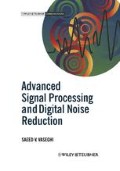Abstract
Impulsive noise are relatively short duration “on/off” pulses, caused by switching noise or adverse channel environments in a communication system, drop outs or surface degradation of audio recordings, clicks from computer keyboards etc. An impulsive noise filter can be used for enhancing the quality and intelligibility of noisy signals, and for achieving robustness in pattern recognition and adaptive control systems. This chapter begins with a study of the characteristics of an impulsive noise, and then proceeds to consider several methods for statistical modelling of an impulsive noise process. The classical method for removal of impulsive noise is the median filter. However, the median filter often results in some signal degradation. For optimal performance, an impulsive noise removal system should utilise (a) the distinct features of the noise and the signal, (b) the statistics of the signal and the noise, and (c) a model of the physiology of the signal and the noise generation. We describe a model-based system that detects each impulsive noise, and then proceeds to replace the samples obliterated by the impulse. We also consider the methods for introducing robustness to impulsive noise in parameter estimation.
Access this chapter
Tax calculation will be finalised at checkout
Purchases are for personal use only
Preview
Unable to display preview. Download preview PDF.
Bibliography
Dempster A. P, Laird N.M and Rubin D.B. (1971), Maximum likelihood from Incomplete Data via the EM Algorithm, Journal of the Royal Statistical Society, Ser. Vol. 39, Pages 1–38.
Godsil S. (1993), Restoration of Degraded Audio Signals, Cambridge University Press, Cambridge.
Gallagher N.C., Wise G.L. (1981), A Theoretical Analysis of the Properties of Median Filters, IEEE Transactions on Acoustics, Speech and Signal Processing, Vol. ASSP-29, Pages 1136–41
Jaynat N.S. (1976), Average and Median Based Smoothing for Improving Digital Speech Quality in the Presence of Transmission Errors, IEEE Trans. Commun. pages 1043–45, Sept issue.
Kelma V.C and Laub A.J (1980), The Singular Value Decomposition: Its Computation and Some Applications, IEEE Trans. Automatic Control, Vol. AC-25, Pages 164–76.
Kunda A., Mitra S., Vaidyanathan P. (1984), Applications of Two Dimensional Generalised Mean Filtering for Removal of Impulsive Noise from Images, IEEE Trans, ASSP, Vol. 32, No. 3, Pages 600–609, June.
Milner B. P. (1995), Speech Recognition in Adverse Environments, PhD Thesis, University of East Anglia, UK.
Nieminen, Heinonen P, Neuvo Y (1987), Suppression and Detection of Impulsive Type Interference using Adaptive Median Hybrid Filters, IEEE. Proc. ICASSP-87 Pages 117–20.
Tukey J.W. (1971), Exploratory Data Analysis, Addison Wesley, Reading, Mass.
Rabiner L.R., Sambur M.R. and Schmidt C.E. (1984), Applications of a Nonlinear Smoothing Algorithm to Speech Processing, IEEE Trans, ASSP, Vol. 32, No.3 June.
Vaseghi S.V., Rayner P.J.W (1990), Detection and Suppression of Impulsive Noise in Speech Communication Systems, IEE Proc-I Communications Speech and Vision, Pages 38–46, February.
Vaseghi S. V., Milner B. P. (1995), Speech Recognition in Impulsive Noise, IAcoustics, Speech and Signal Processing, CASSP-95, Pages 437–40.
Author information
Authors and Affiliations
Rights and permissions
Copyright information
© 1996 John Wiley & Sons Ltd. and B.G. Teubner
About this chapter
Cite this chapter
Vaseghi, S.V. (1996). Impulsive Noise. In: Advanced Signal Processing and Digital Noise Reduction. Vieweg+Teubner Verlag. https://doi.org/10.1007/978-3-322-92773-6_11
Download citation
DOI: https://doi.org/10.1007/978-3-322-92773-6_11
Publisher Name: Vieweg+Teubner Verlag
Print ISBN: 978-3-322-92774-3
Online ISBN: 978-3-322-92773-6
eBook Packages: Springer Book Archive

